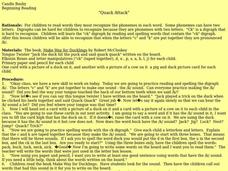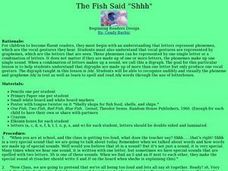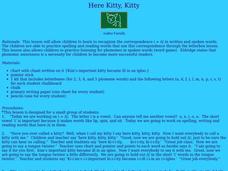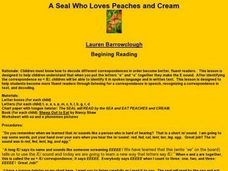Curated OER
Elmer the Elephant
First graders recognize the short vowel E in written and spoken language. Through matching activities, they discriminate the short vowel /e/ from other phonemes. Students associate the phoneme with its letter representation and spell...
Curated OER
Quack Attack
Students identify phonemes in words. They read and spell words that contain the /ck/ digraph. Students read the book Make Way for Ducklings. They practice reading and identifying words with the ck digraph while reading the story.
Curated OER
I Ate Grape Cake
Students distinguish between the sounds for short vowel a and long vowel a. They are introduced to the vowel patterns that comprise long vowel sounds, with a particular emphasis on vowel-consonant-e pattern. They practice reading and...
Curated OER
Shhhhhhh! The sheep are sleeping!
Students examine the use of /sh/ in written and spoken words by watching how their mouth moves while making the sound, identifying words, listening to a story, and making words with Elkonin letterboxes. As an assessment, they complete a...
Curated OER
Mr. Cloak Loads his Boat with Oats
First graders distinguish between the sounds for short vowel o and long vowel o. They are introduced to the vowel patterns that comprise long vowel sounds, with a particular emphasis on /oa/. They practice reading and identifying a...
Curated OER
The Fish Said "Shhh"
Young scholars identify the digraph /sh/ in written and spoken language. After a brief discussion of the independent and combined sounds of the phonemes /s/ and /h/ students practice identifying initial and final placement of the new...
Curated OER
Here Kitty, Kitty
Learners recognize the short vowel i in written and spoken language. Through matching activities, they discriminate the short vowel /i/ from other vowel sounds. Students associate the phoneme with its letter representation and identify...
Curated OER
The Big Pig
Learners recognize the short vowel i in written and spoken language. Through matching activities, they discriminate the short vowel /i/ from other vowel sounds. Students associate the phoneme with its letter representation and identify...
Curated OER
"OU" O U Hurt Me!
Students explore the digraph ou=/ow/ in written and spoken words. They practice writing words with the ou=/ow/ digraph. Students match phonemes in words they hear. Students read The Napping House and identify words with the ou=/ow/ digraph.
Curated OER
It's Icky Icky Sticky
Students recognize the short vowel i in written and spoken language. Through listening and matching activities, they discriminate the vowel sound /i/ from other phonemes. Students identify the phoneme and letter in pseudo words they decode.
Curated OER
Sammy the Slimy Snake
Young scholars engage in a emergent literacy instructional activity with the intention of improving reading comprehension. The goals of the instructional activity include recognizing both upper and lower case S, to create an awareness of...
Curated OER
What doe the doctor say?
Young scholars must explore the phoneme awareness. They must decode many different correspondences. Students explore the o sound by illustrating the concept using memorable tools used in by showing the o sound in spoken and written words.
Curated OER
Ike's Ice Cream is Icy
Students recognize the short vowel i in written and spoken language. Through matching and listening activities, they discriminate the short vowel /i/ from other phonemes. Students associate the phoneme with its letter representation and...
Curated OER
Eddie the Egg
First graders recognize the short vowel e in written and spoken language. Through matching activities, they discriminate the short vowel /e/ from other phonemes. Students associate the phoneme with its letter representation and identify...
Curated OER
Alligator Open Wide
First graders recognize the short vowel a in written and spoken language. Through listening activities, they discriminate the vowel sound /a/ from other phonemes. Students associate the phoneme with its letter representation and identify...
Curated OER
It's Icky Sticky
Learners recognize the short vowel a in written and spoken language. Through matching and listening activities, they discriminate the vowel sound /a/ from other phonemes. Students identify the phoneme and letter in pseudo words they decode.
Curated OER
Unopened Umbrella
Students explore vowel correspondences. They discuss the vowel correspondence u=/u/. They identify u=/u/ in written words and a meaningful representation and letter symbol for the sound. Students read and write words using u=/u/.
Curated OER
Shiny Shells on the Shore
Students investigate how: A single phoneme, which is a vocal gesture in spoken words, can be represented by more than one grapheme. Also how a digraph is the combination of two letters that make one sound (there are both vowel and...
Curated OER
Adam's Apples
Students recognize the short vowel "A" in written and spoken language. Through matching and listening activities, they discriminate the short vowel /a/ from other vowel phonemes. Students associate the phoneme with its letter...
Curated OER
Iiicky, Stiicky, I
First graders recognize the short vowel i in written and spoken language. Through listening and matching activities, they discriminate the vowel sound /i/ from other phonemes. Students identify the phoneme and letter in psuedo words they...
Curated OER
Icky Sticky Tin Man
Students recognize the short vowel i in written and spoken language. Through listening and matching activities, they discriminate the vowel sound /i/ from other phonemes. Students associate the phoneme with its letter representation and...
Curated OER
Icky, Icky, Sticky!
Students recognize the short vowel I in written and spoken language. Through matching activities, they discriminate the short vowel /i/ from other vowel sounds. Students associate the phoneme with its letter representation and identify...
Curated OER
Can You Open the Creaky Door?
Young scholars recognize the short vowel e in written and spoken language. Through matching and listening activities, they discriminate the vowel sound /e/ from other phonemes. Students identify the phoneme and letter in words and pictures.
Curated OER
A Seal Who Loves Peaches and Cream
Young scholars decode correspondence in order to become better, fluent readers. When the letters e and a are put together they make the E sound. They become more fluent readers through listening for a correspondence in speech, in text,...
Other popular searches
- Tongue Twister Poems
- Tongue Twisters P Sample
- Past Tense Tongue Twister
- Poetry Tongue Twisters
- /P/ Sound Tongue Twisters
- P Sound Tongue Twisters
- Phoneme /D/ Tongue Twister

























